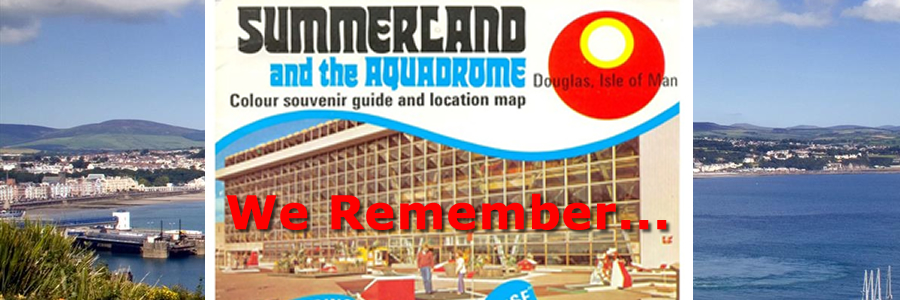50 years ago, today – at approx 7:30pm (BST) on Thursday 2nd August 1973, a fire started at the Summerland Leisure Centre in Douglas on the Isle of Man.
By the time the fire was finally put out, 50 people had died, inc 10 children, and over 80 people were seriously injured.
Summerland was opened on the 25th May 1971. Claimed to be the largest indoor leisure complex in Europe, it had seven floors and three-and-a-half acres of facilities, including an Aquadrome. The cost of the build was £2m.
The Exterior and the Interior of the building were each designed by different architects, who failed to talk with each other and consequently created a venue with numerous fire risks, which were not apparent at the time of opening.
Summerland was designed to accommodate up to 10,000 tourists and consisted of a dance hall, five floors of holiday games, a roller-skating rink, restaurants and public bars. It was an example of modern architecture incorporating an advanced controlled internal climate, built with novel construction techniques using new plastic materials.
The street frontage and part of the roof was clad in Oroglas, an orange coloured transparent acrylic glass sheeting material.
The fire started at around 7:30 p.m. on 2 August 1973 when approximately 3,000 people were inside, and was caused by three boys who were smoking in a small disused kiosk on the centre’s miniature golf course.
The burning kiosk collapsed against the exterior of the building, which was clad in a material called Galbestos; a steel sheeting with asbestos felt on both sides coated with bitumen, with no fire-resistant qualities.
The fire spread to the wall’s interior soundproofing material, which was highly combustible, causing an intense fire that ignited the flammable acrylic sheeting that covered the rest of the building.
The fire quickly spread across the sheeting on the leisure centre walls and roof, and through vents which were not properly fireproofed.
The acrylic material melted, allowing more oxygen to enter, and dropping burning molten material, both starting other fires and injuring those trying to escape.
There was no attempt to evacuate the 3,000 people present until the flames prompted a panic-stricken mass rush for the exits.
The fire was contained in an internal space within the walls until it penetrated the interior, destroying the wiring of the fire alarm system in the process.
Because of the locked fire doors, many people headed to the main entrance, which caused a crush.
The fire services were not called for over 20 minutes, and even then, the call did not originate from Summerland.
Instead the first call came from a passing taxi driver, while another came from the captain of a ship 2 miles (3.2 km) offshore who radioed HM Coastguard and said, “It looks as if the whole of the Isle of Man is on fire”.
The coastguard immediately called the fire brigade.
The first fire crews on the scene realised more help would be required and almost every resource available to the Isle of Man Fire and Rescue Service was mobilised to the incident (93 of its 106 firefighters and all 16 of its engines).
On 17 September 1973, three Liverpool boys – two of them 12 and the other 14 – appeared before Douglas Juvenile Court and admitted wilfully and unlawfully damaging the lock of a plastic kiosk next to Summerland.
They were each fined £3 (equal to £31.86 in 2020) and ordered to pay 33p compensation and 15p costs.
The centre was seriously damaged by the fire.
Its charred steel skeletal remains were demolished in 1975 and then rebuilt on a smaller scale, construction commencing in 1976, with a smaller area of glass than the original, and a highly advanced fire extinguisher and alarm system.
The centre reopened in June 1978.
In October 2002, heavy rain caused damage to the structures, as well as two landslides behind Summerland which dislodged two 50-tonne concrete blocks that had once supported the roof of the original building, but had not been removed when the original structure was demolished.
A team determined that the blocks could not be safely stabilised or removed, and that there was a risk they would fall into the buildings below, so the site was scheduled for demolition.
Demolition began in January 2006. Today, the site where the Summerland leisure center once sat is an empty, undeveloped space.
Forty years after the tragedy, a permanent memorial in the form of three granite columns was unveiled at Kaye Memorial Gardens, at the bottom of Summer Hill.
It bears the names of those killed in the fire and is set into a circle of paving, alongside a stone laid earlier to mark the 25th anniversary.
My connection is a very personal one – my Mother-in-Law, and young Brother-in Law, were on holiday in the Isle of Man on the day of the disaster.
They had been in Summerland earlier that day – but had left to go back to Peel for the afternoon.
We remember all those who died and all who were injured.

